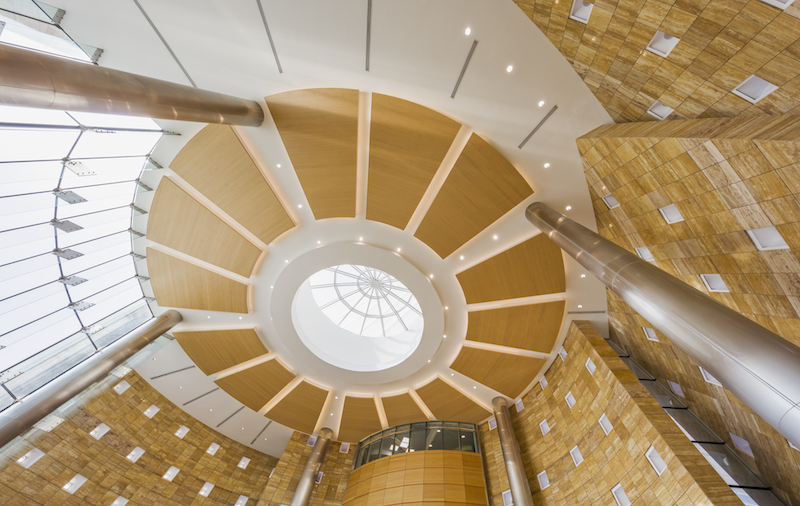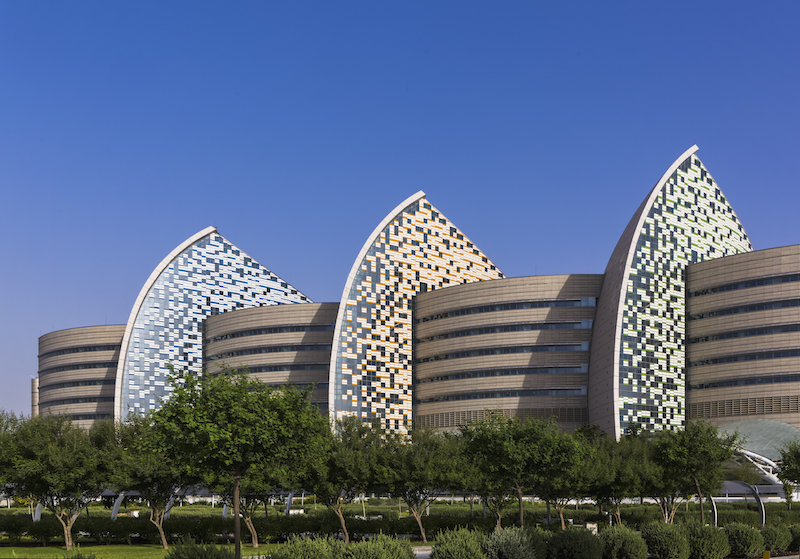This spring, the 1-million-sf Sidra Medicine in Doha, Qatar, is scheduled to launch a purpose-built clinic with in vitro fertilization services for reproductive consultation.
The hospital, which had its official opening on November 12, is one of the few in Qatar offering health services specifically for women and children. The facility, whose nearly $8 billion construction cost was endowed by Qatar Foundation, has more than 50 outpatient clinics and 400 inpatient beds, expandable to 550.
The hospital’s exterior design, by New Haven, Conn.-based Pelli Clarke Pelli Architects, is distinguished by three sails that take their cue from traditional boats known as dhows, and from sand patterns in Doha “that are quite beautiful,” says Mark Shoemaker, a Principal with Pelli Clarke Pelli. “These fluid forms inspired us.”

The hospital has three massive atriums, bathed in natural light. Image; Jeff Goldberg_Esto
The sails, clad in white ceramic tile, are part of massive atriums within the building, one of which includes a garden respite. The hospital also has a mosque, an ambulatory care center, and underground parking for 1,000 cars.
The medical center is positioned as a gateway to Education City, Doha’s 1.4-square-kilometer concentration of academic, science, and sports facilities. A tunnel connects the hospital directly to Cornell Weill Medical School, one of six campuses at Education City. (Other campuses are for Texas A&M, Carnegie Mellon University, and Virginia Commonwealth.)
The construction of Education City, which debuted in 1997, and Sidra Medicine was spearheaded by Sheikha Moza bint Nasser, chairperson of Qatar Foundation and consort to Sheikh Hamad bin Khalifa Al Thani, Qatar’s former Emir. Her Highness has been instrumental in advancing education and social reform in her country.
Shoemaker says Pelli Clarke Pelli was brought into the project by AECOM. (He once worked for Ellerbe Beckett, which designed the first Mayo Clinic. That firm is now part of AECOM). The team unveiled its design for Sidra Medical in 2007, and construction began in 2010.
Completion of the hospital was originally slated for 2011, and then 2015. The delays, explains Shoemaker, were partly attributable to the building’s size and complexity, but also to Building Team-related changes.
The hospital employs more than 4,000 people with 85 nationalities. Image: Sidra Medical and Research Center.
At one point AECOM left the project that then switched to a design-build delivery method led by Spain-based general contractor OHL, which had been in a joint venture with Contrack International for this project since 2008. Qatar Foundation fired OHL over delays in 2014, and OHL subsequently sued the foundation. Eventually, AECOM came back into the picture.
Sidra Medicine actually has been receiving patients since January 2018, and has staggered the opening of different departments—like robotic surgery last July. Shoemaker suggests this could be because Qatar doesn’t have enough trained medical professionals to meet the needs of such a large facility, and Sidra Medical has had to fill those gaps by recruiting (with Cornell Weill’s assistance) medical personnel from outside the country, mostly the United States and Europe.
When asked what his firm took away from this project, Shoemaker says that “it gave us the opportunity to experiment with different healthcare models for rooms and lobbies.” He adds that the design also paid attention to reflect Qatar’s culture.
Related Stories
| Aug 11, 2010
Gafcon announces completion of Coronado animal care facility
Gafcon, a leading California-based construction management and consulting firm, announced today that construction is now complete on a new $1.6 million animal care facility located at 1395 First Street in Coronado, Calif.
| Aug 11, 2010
Colorado hospital wins LEED Gold
The main building of the Medical Center of the Rockies in Loveland, Colo., is a 136-bed regional medical center offering a full spectrum of services, with specialties in cardiac and trauma care. Constructed primarily of brick, native sandstone, and 85,000 sf of metal panels manufactured by Centria, the 600,000-sf main building, by Denver-based HLM Design, is one of the few hospitals in the nati...
| Aug 11, 2010
Biomedical center to join London's research scene
The UK Centre for Medical Research and Innovation, a partnership of scientific organizations researching new treatments for illnesses such as cancer and heart disease, hopes to attract leading medical scientists to its planned research center. Designed by HOK London, the building will be located on 3.
| Aug 11, 2010
Design ups comfort, care in cancer center
A new cancer center is slated to open in fall 2011 at Banner Gateway Medical Center, Gilbert, Ariz. The three-story, 120,000-sf, $107 million cancer center will contain physician clinics, medical imaging, radiation oncology, infusion therapy, and support services. A/E firm Cannon Design has created a visually open, column-free interior to increase patient comfort and care.
| Aug 11, 2010
Charlotte hospital expands its surgery capabilities
The Chicago office of RTKL designed Carolinas HealthCare System's Mercy Medical Plaza, Charlotte, N.C. The 150,000-sf hospital houses 12 operating rooms with expanded pre-operative and recovery space, a pharmacy, and a central sterile processing unit. Tenant space occupies 75,000 sf. RTKL mimicked the materials and mass of older buildings on the campus but created a more modern look by using ex...
| Aug 11, 2010
And the world's tallest building is…
At more than 2,600 feet high, the Burj Dubai (right) can still lay claim to the title of world's tallest building—although like all other super-tall buildings, its exact height will have to be recalculated now that the Council on Tall Buildings and Urban Habitat (CTBUH) announced a change to its height criteria.
| Aug 11, 2010
East meets West in hospital design
The Los Angeles office of HMC Architects and the Chinese firm Shunde Architectural Design Institute won the commission to design the 2.15 million-sf First People's Hospital in the Shunde District of Foshan, China. The team's winning concept organizes a series of buildings around a dynamic, curved spine element to create an interior “eco-atrium” with outdoor green space and healing g...
| Aug 11, 2010
MOB added to new hospital project
A late-2009 ground breaking is planned for a $20 million medical office building on the grounds of the $211 million, 106-bed Loma Linda University Medical Center in Murrieta, Calif., which itself is under construction. Minneapolis-based Frauenshuh HealthCare Real Estate Solutions is developing the five-story, 160,000-sf MOB, which will accommodate 60 physician offices.
| Aug 11, 2010
Rehabilitation center helps patients transition
Construction is under way on the Polytrauma Transitional Rehabilitation Center on the VA Medical Center campus in Richmond, Va. The $8 million, 22,000-sf facility will provide physical therapy, housing, and education to veterans as part of their transition back into their communities. The center was designed by HDR, Alexandria, Va.
| Aug 11, 2010
Medical office building planned in Fort Worth, Texas
Dallas-based TGS Architects has unveiled its design for the five-story, 130,000-sf Plaza Medical Office Building, planned for Fort Worth, Texas. The Class A development will include space for orthopedic care, surgery, breast center, diagnostic imaging, cardiovascular, and rehabilitation therapy services.







